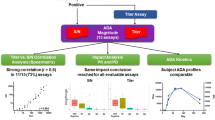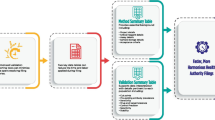Abstract
Assays for the detection and confirmation of anti-drug antibodies (ADA) are commonly used tools for assessing the immunogenicity of drug candidates in both clinical and nonclinical studies. During the development of such assays, it is typical to optimize the assay conditions based on factors such as sensitivity or signal/noise ratio (S/N) and is commonly done using an assay positive control (PC). However, even carefully optimized methods often suffer with problems due to low cut-point factors and failure to distinguish assay “noise” from a true biological response. In this paper, we describe an approach to assay development in which the impacts of assay conditions on the response and variability, both analytical and biological, of drug-naïve samples are tested by way of PC-independent assay condition optimization. Using two ADA methods as model systems, we examine the impact of minimum required dilution, assay reagent (labeled drug) concentrations, incubation time, assay, and wash buffer composition. We find that the choice of assay conditions, particularly the labeled drug concentration, can greatly affect the distribution of naïve sample responses and thus impact screening and confirmatory assay cut-points. In two case studies presented, screening assay cut-point (SCP) varied from 1.38 to 2.20 and 1.04 to 1.20 while the confirmatory assay cut-point (CCP) varied from 58.5 to 95.6% and 26.2 to 16.2% depending on the conditions tested. Some of the conditions produced unacceptably high CCP values. It is proposed that the degree of the observed impact of the assay conditions on SCP and CCP values depends on the compound nature and assay matrix composition and is likely connected with the diversity of interactions between drug protein and matrix components. Because it was also observed that higher assay SCP can associate with a loss of the PC-based assay sensitivity, additional assessment of the assay conditions would be required to determine an overall assay performance acceptability, including assay PC-based sensitivity, drug, and target tolerance characteristics. In conclusion, it is suggested that by assessing performance of treatment-naïve samples at various assay conditions, one can identify potential assay protocols that allow to avoid undesirably low screening (e.g., < 1.2) and confirmatory (e.g., < 25%) cut-points.








Similar content being viewed by others
References
FDA. Immunogenicity testing of therapeutic protein products—developing and validating assays for anti-drug antibody detection. Guidance for Industry. U.S. Department of Health and Human Services Food and Drug Administration. Center for Drug Evaluation and Research (CDER). Center for Biologics Evaluation and Research (CBER); 2019 [cited 2019]; 2019: Available from: https://www.fda.gov/ucm/groups/fdagov-public/@fdagov-drugs-gen/documents/document/ucm629728.pdf. Accessed 28 May 2019
Committee for Medicinal Products for Human Use C. Guideline on immunogenicity assessment of therapeutic proteins; 2017. Available from: https://www.ema.europa.eu/documents/scientific-guideline/guideline-immunogenicity-assessment-therapeutic-proteins-revision-1_en.pdf. Accessed 28 May 2019
Rispens T, Ooievaar-De Heer P, Vermeulen E, Schuurman J, van der Neut Kolfschoten M, Aalberse RC. Human IgG4 binds to IgG4 and conformationally altered IgG1 via Fc-Fc interactions. J Immunol. 2009;182(7):4275–81. https://doi.org/10.4049/jimmunol.0804338.
Rispens T, de Vrieze H, de Groot E, Wouters D, Stapel S, Wolbink GJ, et al.. Antibodies to constant domains of therapeutic monoclonal antibodies: anti-hinge antibodies in immunogenicity testing. J Immunol Methods. 2012;375(1–2):93–9. https://doi.org/10.1016/j.jim.2011.09.011.
Galili U. Anti-Gal: an abundant human natural antibody of multiple pathogeneses and clinical benefits. Immunology. 2013;140(1):1–11. https://doi.org/10.1111/imm.12110.
Galili U, Anaraki F, Thall A, Hill-Black C, Radic M. One percent of human circulating B lymphocytes are capable of producing the natural anti-Gal antibody. Blood. 1993;82(8):2485–93.
Arnold DF, Misbah SA. Cetuximab-induced anaphylaxis and IgE specific for galactose-alpha-1,3-galactose. N Engl J Med. 2008;358(25):2735; author reply -6. https://doi.org/10.1056/NEJMc080834.
Ghaderi D, Taylor RE, Padler-Karavani V, Diaz S, Varki A. Implications of the presence of N-glycolylneuraminic acid in recombinant therapeutic glycoproteins. Nat Biotechnol. 2010;28(8):863–7. https://doi.org/10.1038/nbt.1651.
van Ree R, Cabanes-Macheteau M, Akkerdaas J, Milazzo JP, Loutelier-Bourhis C, Rayon C, et al.. Beta(1,2)-xylose and alpha(1,3)-fucose residues have a strong contribution in IgE binding to plant glycoallergens. J Biol Chem. 2000;275(15):11451–8.
Rieder F, Hahn P, Finsterhoelzl L, Schleder S, Wolf A, Dirmeier A, et al.. Clinical utility of anti-glycan antibodies in pediatric Crohn’s disease in comparison with an adult cohort. Inflamm Bowel Dis. 2012;18(7):1221–31. https://doi.org/10.1002/ibd.21854.
Dai S, Schantz A, Clements-Egan A, Cannon M, Shankar G. Development of a method that eliminates false-positive results due to nerve growth factor interference in the assessment of fulranumab immunogenicity. AAPS J. 2014;16(3):464–77. https://doi.org/10.1208/s12248-014-9581-z.
Zhong ZD, Clements-Egan A, Gorovits B, Maia M, Sumner G, Theobald V, et al.. Drug target interference in immunogenicity assays: recommendations and mitigation strategies. AAPS J. 2017;19(6):1564–75. https://doi.org/10.1208/s12248-017-0148-7.
van Schie KA, Wolbink G-J, Rispens T. Cross-reactive and pre-existing antibodies to therapeutic antibodies—effects on treatment and immunogenicity. mAbs. 2015;7(4):662–71. https://doi.org/10.1080/19420862.2015.1048411.
Gorovits B, Clements-Egan A, Birchler M, Liang M, Myler H, Peng K, et al.. Pre-existing antibody: biotherapeutic modality-based review. AAPS J. 2016;18(2):311–20. https://doi.org/10.1208/s12248-016-9878-1.
Shankar G, Devanarayan V, Amaravadi L, Barrett YC, Bowsher R, Finco-Kent D, et al.. Recommendations for the validation of immunoassays used for detection of host antibodies against biotechnology products. J Pharm Biomed Anal. 2008;48(5):1267–81. https://doi.org/10.1016/j.jpba.2008.09.020.
Song S, Yang L, Trepicchio WL, Wyant T. Understanding the supersensitive anti-drug antibody assay: unexpected high anti-drug antibody incidence and its clinical relevance. J Immunol Res. 2016;3072586. https://doi.org/10.1155/2016/3072586.
Kubiak RJ, Zhang J, Ren P, Yang H, Roskos LK. Excessive outlier removal may result in cut points that are not suitable for immunogenicity assessments. J Immunol Methods. 2018;463:105–11. https://doi.org/10.1016/j.jim.2018.10.001.
Liang M, Klakamp SL, Funelas C, Lu H, Lam B, Herl C, et al.. Detection of high- and low-affinity antibodies against a human monoclonal antibody using various technology platforms. Assay and drug development technologies. 2007;5(5):655–62. https://doi.org/10.1089/adt.2007.089.
Acknowledgments
The authors want to thank Alexander Fichtner, Judith Smith, and Lyudmyla Kunovska for performing sample analysis, and Will Somers for helpful data review and discussions.
Author information
Authors and Affiliations
Corresponding author
Additional information
Publisher’s Note
Springer Nature remains neutral with regard to jurisdictional claims in published maps and institutional affiliations.
Rights and permissions
About this article
Cite this article
Gorovits, B., Wang, Y., Zhu, L. et al. Anti-drug Antibody Assay Conditions Significantly Impact Assay Screen and Confirmatory Cut-Points. AAPS J 21, 71 (2019). https://doi.org/10.1208/s12248-019-0342-x
Received:
Accepted:
Published:
DOI: https://doi.org/10.1208/s12248-019-0342-x




